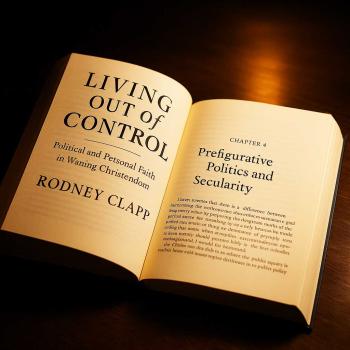
The other week, I was talking with a friend of mine who is pastor of an evangelical congregation in Texas.
He was asking for my input on a multi-week series comparing different “world religions” with Christianity at his church.
Numerous, well-meaning pastors, lay leaders, and teachers like my friend have led such comparative studies in their own communities as a means to help Christians navigate contemporary religious pluralism. I even led a few of my own in my early days. While most of the leaders of these studies start with the intention to help their parishioners learn more about the world's religions, the way they go about it usually leads to nominally increased religious literacy. Even worse, these studies can exacerbate pre-existing prejudices or presuppositions about the religions they set out to better understand.
Which raises the question of whether there is any promise to comparing things like Christianity and Islam, the Quran and the Bible at all. The problem, I suggest, might lie in the very act of comparison itself.
Comparative religion and its discontents
Although the idea of comparing one religion to another, or one scripture to another, seems simple enough, it is a tradition steeped in a particular history, with a range of potential pitfalls.
At its heart, comparison always starts with an assumption of similarity and difference, of resonance and dissonance between two objects, people, places, or in our case, religious traditions.
The hope is that by comparing two things — the known with the unknown, the foreign with the familiar — we might better understand the world and reconsider our place in it. This is comparison’s promise.
The problem is that we can never assume our comparison is neutral. Comparison is always done by particular people coming from particular perspectives in an attempt to organize and make sense of their world for specific purposes.
In my friend’s case, it was evangelical Christians in Texas trying to come to terms with diversity and difference. Comparative religious studies itself emerged out of a similar desire, wrote critical religion scholars Russel McCutcheon and Aaron Hughes in their book Religion in 50 Words:
Comparison arose…on account of the inevitable failure of local understandings (e.g., claims concerning the uniqueness and thus incomparability of Christianity) when confronted with new and unanticipated information (e.g., reports of the surprisingly familiar-looking beliefs and practices of people from other parts of the world).
Early comparativists took to studying Ancient Near Eastern religions, Buddhist and Hindu traditions, or Islam, putting them in comparison with Christian texts, theologies, and practices. This meant importing their own categories into an unfamiliar context and then imposing those same categories on others’ scriptures, beliefs, and rituals. The very categories they used (e.g., text, traditions, theology, ritual, etc.) were taken from Christian history and its ways of ordering the world.
In seeking to understand the unfamiliar, we often end up making it conform to categories with which we are already familiar. In religious studies, the result was a distorted vision of other traditions that neutered their reality in order to suit our own preoccupations and presuppositions. In other words, “comparative studies decontextualize and essentialize” diverse and often dissimilar religious phenomena.Different paths up different mountains
One of the ways I like to explain this is in reference to two analogies used by religion scholars past and present.
The first is from John Hick. In his attempt to put forward a theory of religion, Hicks used the metaphor of a mountain (he also used one about blind men and an elephant). In his mountain metaphor, we are all spiritual mountain climbers. Different religions represent different paths up the same divine peak. While each path may be different, the goal is the same. Such a view was also embedded within works by famous metaphysicist Frithjof Schuon, perennial philosopher Aldous Huxley, and religion scholar Huston Smith.
But as numerous critics have pointed out, Hick’s metaphor only works if we are all trying to climb the same mountain. As scholar Stephen Prothero explained in his book God is Not One, it might be better to think of the world’s different religious traditions as varying attempts to scale very different mountains, each with their own problems, solutions, and techniques.
Thus, any attempt at comparison would have to start from the ground up, with the tectonics of the tradition and how the very terrain it is situated in gave rise to that particular religious mountain in the first place. Only then could we begin to compare mountains, let alone the paths people take to climb them.
Could comparative theology come to the rescue?
Another attempt to try and ameliorate the worst of comparative religion is “comparative theology.”
Coined by Francis X. Clooney and developed by numerous scholars since, comparative theology is a constructive, dialogic, and “deep” theological exploration of a topic, theme, or phenomenon that brings two or more traditions into conversation with one another. Not to be confused with comparative religion on the one hand or interreligious dialogue on the other, comparative theology is about “learning across religious borders” inviting theological reflection “in light of the insights of another religious tradition.”
As such, it brings theologians into a method that starts with a critical appraisal of their own presuppositions. So far, so good.
Particularly for Christians, comparative theology can hold much promise. It seems to jive with Prothero’s “many mountains” approach in that comparative theology begins with the premise that each tradition tells its own story, in its own words, and the would-be comparativist would be wise to engage in a lot of humble listening and learning, before any kind of comparison or criticism.
Such a posture is well and good, but comparative theology is not without its own problems. First, comparative theology can remain a confessional, even apologetic, theology.
Second, comparative theology remains a largely text-based discipline where theologians engage, juxtapose, and ‘use-together’ texts and teachings from different traditions. This means reading another’s scriptures and theological texts all the while gaining a comfortable familiarity with the vocabulary and discourse of another tradition.
Recent examples would include Jerusha Tanner Lamptey’s work in comparative feminist theologies, S. Mark Heim’s analysis of the bodhisattva path in Māhayāna Buddhism from a Christian perspective, or Hyo-Dong Lee’s comparative analysis of the concepts of spirit and qi. On a more popular level, it can also be seen in attempts to compare the Bible and the Quran, whether by German scholars or Dutch YouTubers.
Let’s be careful…
Before we get too carried away, however, I still have a few cautions out there for religion nerds keen to compare.
Not only are texts like the Bible and the Quran two very different holy books written and recorded at dissimilar times (in fact, over a multi-thousand-year span) and with different genres, approaches, rules of interpretation, and problems addressed and solved, but the tendency to use texts for comparison returns us to the particularly Christian presupposition that texts are the fundamental bases of religious traditions.
That is, however, not always the case.
Furthermore, if we take texts at face value, we often forget that writing and reading are very human activities, all done to suit the contextual purposes of the people doing them.
If there is any promise to the practice of comparison then, it might be a good idea to move away from theologies supposedly enshrined in texts and instead take a more intentional look at what Natalie Wigg-Stevenson calls “theologies embodied in practice.”
This, I suggest, would help us better attend to the specificity of human existence in everyday incidents, experiences, and encounters within, across, and at religious boundaries.
Religion, as I’ve often reminded readers of this blog, is a very human enterprise. Therefore, if we aim to compare religions we have to keep the humans involved from beginning to end. That means considering our human desires and preconceived ideas before we start doing any comparing and then thinking about the particular bodies, contexts, and lifeworlds that developed theologies and traditions over time and in different places.
In that guise, comparison might yet yield promise for those interested in plumbing the mysteries of human existence. But only maybe.
5/6/2023 3:48:16 AM





